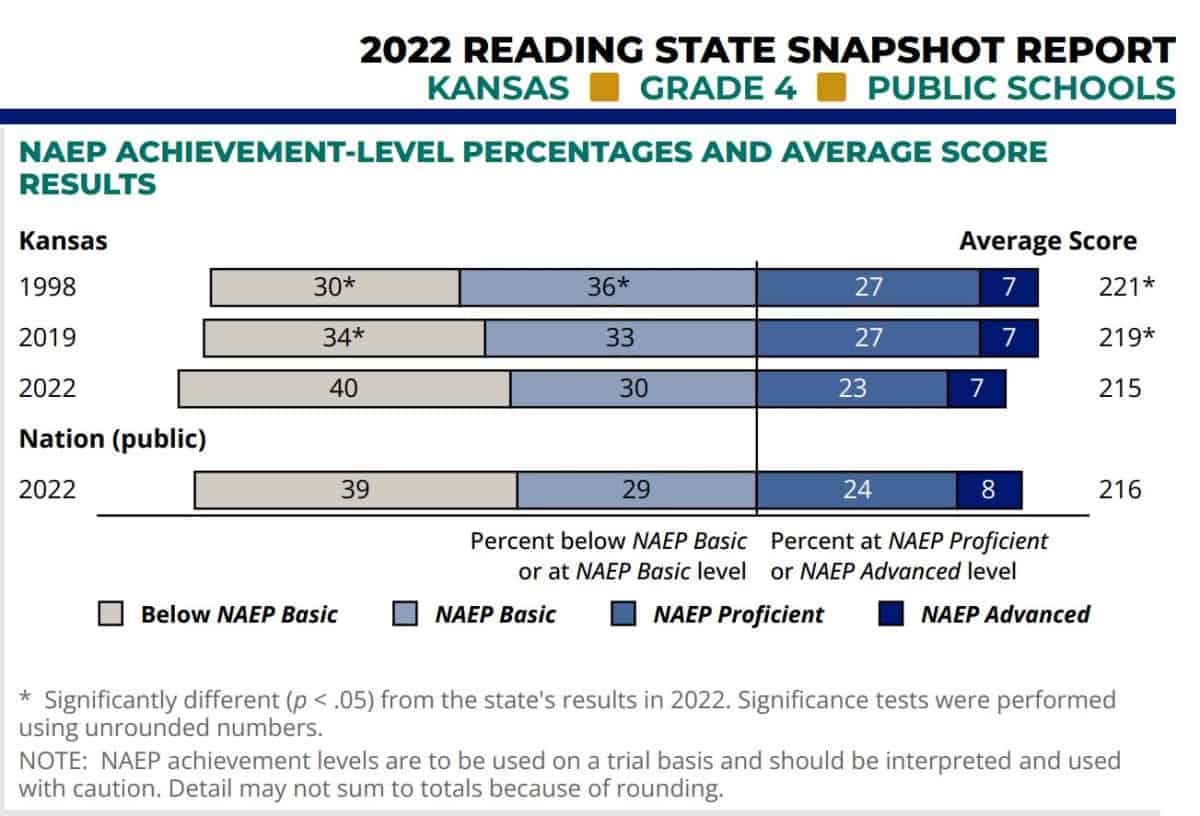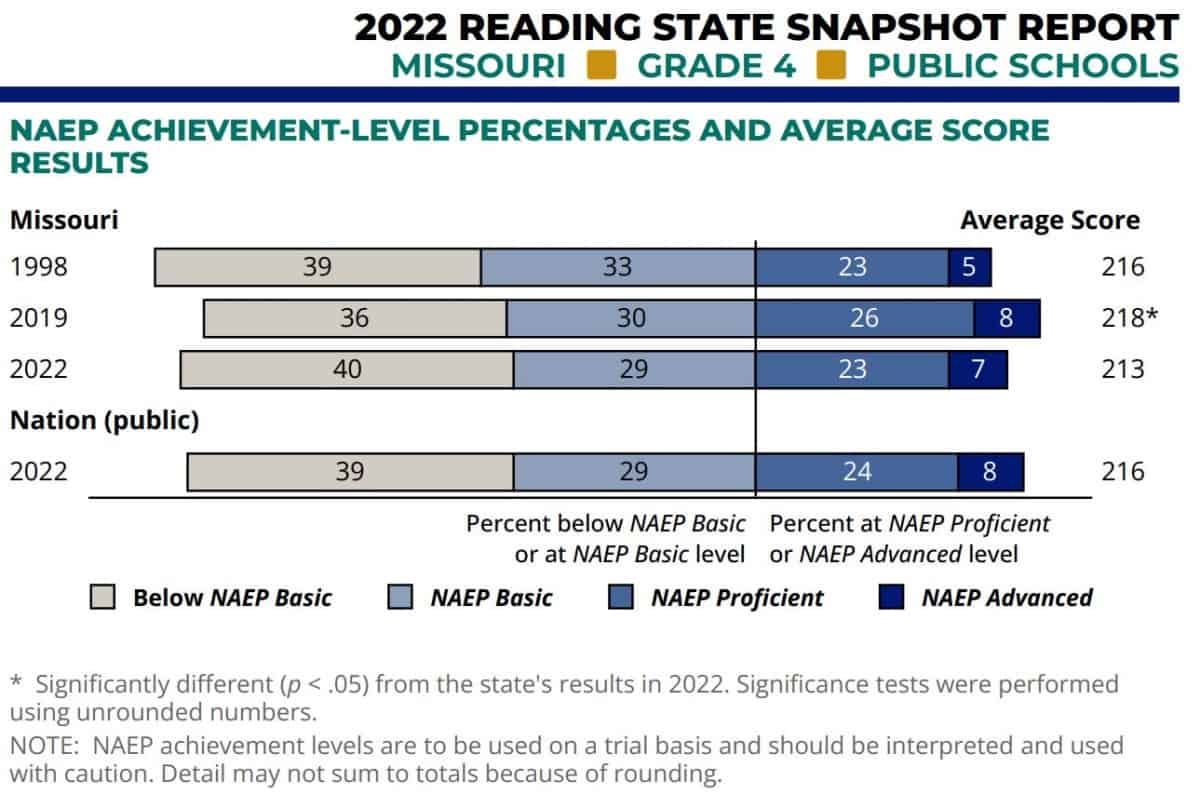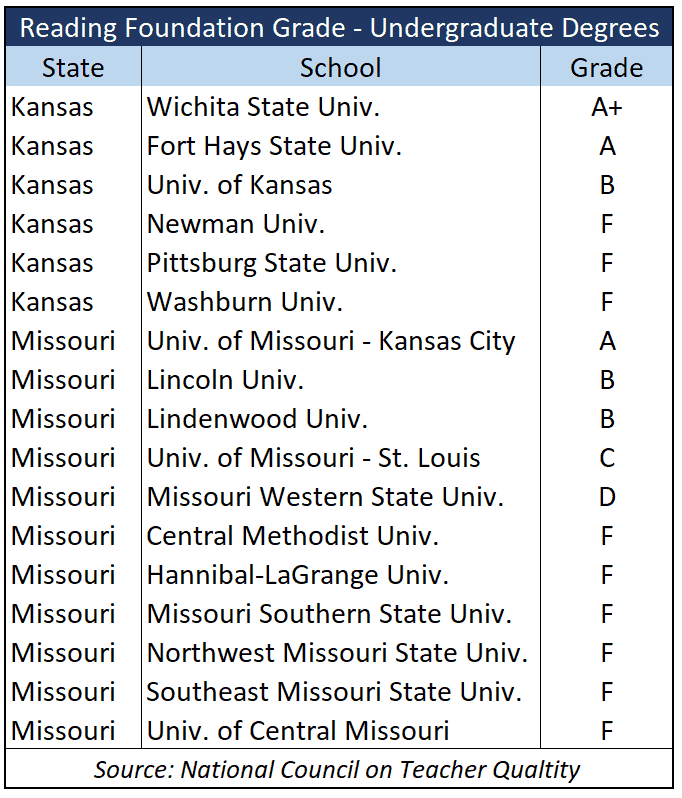A new report from the National Council on Teacher Quality (NCTQ) shows that if the science of reading was being taught properly in universities, the U.S. would not have a serious literacy problem.

Nationally, the report shows 37% of all fourth graders and 39% of fourth-graders in public school are below the basic level on the National Assessment of Educational Progress, and as the Sentinel previously reported, Kansas fares worse.
In Kansas, the numbers are falling and even worse than the national average, with 40% of fourth graders below the basic level, 30% at basic, and only 30% proficient. In 1998, only 30% were below basic, 36% at basic, and 34% were proficient.
 Missouri, which also has 40% below basic, has shown slight improvement in proficiency, going from 28% proficient in 1998 to 30% proficient in 2022.
Missouri, which also has 40% below basic, has shown slight improvement in proficiency, going from 28% proficient in 1998 to 30% proficient in 2022.
According to NCTQ, half of the undegraduate elementary education programs at univiersities in Kansas get failing grades for teaching the science of reading.
Wichita State was the only Kansas institution to earn an A+ rating on reading education, Fort Hays State earned an A, the University of Kansas a B, and Newman, Pittsburg State and Washburn universities all earned “F” grades.
 Pittsburg State is particularly egregious as it is home to the Center for Research, Evaluation and Awareness of Dyslexia — or READing — a nationally-recognized program that teaches dyslexic children and adults to read.
Pittsburg State is particularly egregious as it is home to the Center for Research, Evaluation and Awareness of Dyslexia — or READing — a nationally-recognized program that teaches dyslexic children and adults to read.
Two state universities — Emporia State and Kansas State were not evaluated because they flatly refused to turn over syllabi.
Shannon Holston, chief of policy and programs for NCTQ, said both institutions refused to give them syllabi for evaluation voluntarily, and denied open records requests, stating the syllabi are the intellectual property of the individual professors.
Holston further said emails to individual professors were not returned.
Only one program examined in Missouri earned an A — the University of Missouri at Kansas City. Lincoln University and and Lindenwood University earned a B.
The literacy crisis does not have to happen
Dr. David Hurford is the Executive Director of READing at Pittsburg State University. He says the reading crisis is not only unacceptable — but has no reason to actually exist.
“Thirty-four percent of our nation’s children (public and private) are not reading at the basic level,” Hurford said. “The National Center for Education Statistics defines reading at the basic level as ‘partial mastery of fundamental skills.’ Not reading at the basic level then indicates that the student does not have a ‘partial mastery of fundamental skills,’ which is sad.”
It is not just students who are struggling, Hurford said.
“There are approximately 93 million adults who cannot read well enough to take their prescription medication,” he said. “The illiteracy rate of adults is simply an outgrowth of poor reading instruction while in school.”
NCTQ was looking for evidence that aspiring teachers were learning about each of the five core components of scientifically-based reading instruction, through four specific instructional approaches.
The five components are:
- Phonemic Awareness — the ability to focus on and manipulate the individual phonemes in spoken words.
- Phonics — the relationship between the sound of spoken words and the individual letters or groups of letters which represent those sounds in written words.
- Fluency — the ability to read a text accurately and quickly, while using phrasing and emphasis to make what is read sound like spoken language.
- Vocabulary — knowledge of the meanings, uses and pronunciations of words, and;
- Comprehension — constructing meaning that is reasonable and accurate by connecting what has been read to what the reader already knows.
The four areas of measurement are Instructional hours, objective measures of knowledge such as tests and quizzes, background materials such as textbooks, articles and other “required reading” and practical application of what the aspiring educators have been taught.
Kansas institutions behind the curve
Wichita State University and Fort Hays State teach all five components, and the University of Kansas has four components in its program, but Newman, Pittsburg State, and Washburn include none of them.
Hurford said the issue is the notion there are “many ways” to teach reading.
“In reality, there isn’t,” he said. “We need to teach the mechanics of reading; that notion that this letter represents this sound. And then you can decode that letter into the sound, synthesize and blend it together, and then have some recognition that what you’re reading is a word you already know.”
The Sentinel reached out to Kansas Commissioner of Education Dr. Randy Watson, to ask if the Kansas State Department of Education — which has a requirement for “structured literacy and/or dyslexia training” — if the science of reading being used by the Center for READing and other states is recommended by KSDE.
Two emails returned received and read receipts, but as of publication, Watson had not responded.
According to the KSDE website, “The Legislative Task Force on Dyslexia and the Kansas State Board of Education have required that schools conduct annual professional development on structured literacy and/or dyslexia. Professional learning is required annually but each school system is allowed to determine the time and duration of the training. The training should be hands-on, with evidence-based practices, on the nature of dyslexia, procedures to identify students who are struggling in reading, intervention strategies and procedures, tiered intervention practices, or progress monitoring.”
But what “evidence-based” practices are required appears to be left to the districts.
Teaching the teachers
NCTQ is an organization that tracks how universities prepare prospective educators for the classroom, and its new report is — essentially — “good news, bad news.”
The good news is that the number of education programs stressing scientifically-based reading instruction is growing. The bad news is that far too many programs continue to teach out-moded and ineffective ways of instructing reading.
NCTQ’s data shows 40% of teacher prep programs are teaching debunked literacy methods, and a recent EducationWeek survey confirms 72% of elementary teachers say they use them.
“NCTQ engaged in a two-year revision process with the field to determine how to evaluate teacher prep programs on preparing aspiring teachers in effective literacy instruction,” the report reads. “The revision sought to keep pace with changes in the field, to recognize that children’s reading proficiency continues to fall short, and to facilitate a transparent and rigorous process that is inclusive of feedback from external stakeholders.”
In addition, NCTQ analyzed the extent to which programs prepare candidates to teach a range of students with diverse needs in learning to read.
The results were somewhat disheartening. NCTQ found that nationally only 25% of teacher education programs adequately address all five core components of reading instruction, and over 40% of programs are still teaching multiple practices contrary to the research.

